These are the UK’s biggest grocery brands by value in the year to 31 December 2022, according to data from NiQ
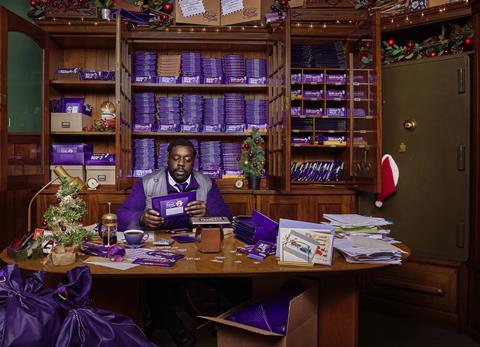
1. Cadbury
2022’s rank: 1
Sales: £1,855.1m (+0.2%)
NPD has been crucial for Britain’s biggest grocery brand. An extra 78 Cadbury products hit shelves in the past year, bringing its portfolio count to 613.
These innovations added £51.5m to Cadbury’s top line. Without them, the Mondelez brand would have lost 2.6% in value and 8.7% in units.
As it stands, however, it’s worth an extra £3.8m – and units are down a relatively modest 5.9%.
“Cadbury has had a strong year of innovation, bringing an array of new flavours, products and formats to retailers’ ranges to help them add excitement and drive confectionery sales,” confirms Susan Nash, trade communications manager at Mondelez.
She points to the February launch of Caramilk Buttons – the brand’s most successful NPD of the year, racking up £8.6m in 10 months.
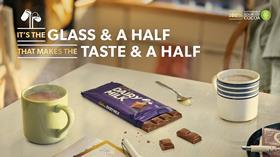
Flavour extensions also helped bring in shoppers. “Cadbury Dairy Milk Mint was the bestselling new standard chocolate tablet of the year, followed by both flavours of Cadbury Mystery Bars,” Nash adds. “Twirl Caramel and Wispa Gold Salted Caramel were two of the top three bestselling new standard chocolate singles bars in 2022.”
The indulgent nature of these hit lines is in stark contrast to Cadbury’s plans for the future. In December, Mondelez announced “ground-breaking” tech that could reduce the amount of sugar and fat from its snacks by up to 75%.
The result of “years of careful development”, it has the potential to create healthier versions of fillings including honeycomb, caramel, nougat, marshmallow and fudge.
It means better-for-you takes on Cadbury’s Crunchie, Double Decker and Fudge bars could soon land on shelves.
Until they do, health-conscious shoppers can content themselves with lower-calorie Cadbury Delights bars, added in January 2023.
There’s also Cadbury Dairy Milk Fruitier & Nuttier, a four-strong range of HFSS-compliant treats unveiled last month. This innovation is shrewd for a couple of reasons. First, it will it allow Cadbury Dairy Milk to appear in prominent retail display locations. Second, the lines come at a significant premium.
Take Fruitier & Nuttier’s two Trail Mix SKUs, which include Buttons and come at £2.50 for a 100g bag. By comparison, a similar sized pack of Giant Buttons is as little as £1.05/100g in the mults.
The larger format of Giant Buttons is even better value – albeit somewhat less so of late. This month, Cadbury shrank the 240g bag by 23% to 184.8g, citing “significantly increased production costs”.
It’s just one example of shrinkflation across the brand. In January 2022, outraged headlines appeared in the tabloids over the smaller pack sizes of Wispa, Curly Wurly, Chomp and Fudge, while prices remained static.
The lines went on to experience mixed fortunes, but declines were less down to headlines and more down to scorching weather. Many sweet-toothed shoppers set aside their favourite chocs during the summer’s heatwave – and many more turned to Cadbury’s ice cream.
Its sales “grew ahead of the category in 2022, adding more value to the market than any other ice cream brand”, says Nash. Overall value hit £65.9m – up 13.6% on units up 3.9%.
Cool stuff!
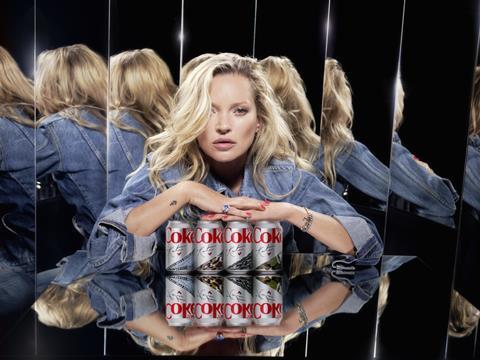
2. Coca-Cola
2022’s rank: 2
Sales: £1,616.4m (+6.1%)
Britain’s biggest soft drinks brand has been getting creative. Last year, it debuted a “global innovation platform” – Coca-Cola Creations – through which it launches limited-edition drinks “inspired by different cultural cues”.
First came Intergalactic, inspired by outer space, followed by Marshmello – created in partnership with the music producer of the same name. Then came Dreamworld and, most recently this year, Movement. All came under the Coke Zero Sugar banner.
Given Coca-Cola enjoys near ubiquity in UK grocers, such creations are all about piquing curiosity and encouraging those who wouldn’t otherwise buy Coke to give it a try.
The plan’s working, says Martin Attock, VP for commercial development at CCEP GB. “Twenty-seven per cent of shoppers who bought into the first limited edition during the launch phase were new to Coca-Cola Zero Sugar, demonstrating how we’re broadening the appeal of the brand.”
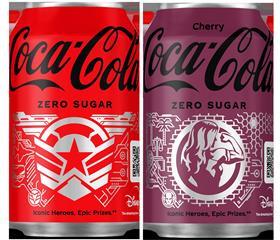
Still, sales of the three Creations products launched in 2022 were modest. They racked up £4.6m between them, representing just 0.3% of Coke’s total value, which has grown by £93.4m.
Classic is up 6.6% to £754.5m, while Diet is up 2% to £495.4m. Zero Sugar remains the growth hero: sales excluding Creations surged 10.8% to £358.7m on units up 7.6%.
“Zero Sugar is a driving force within the Coca-Cola trademark,” says Attock, who points to an on-pack Xbox merchandise giveaway as a highlight in 2022. There was also the launch of the Coke Studio music platform and its activity as the official soda brand of the men’s World Cup.
For Diet Coke, its 40th birthday last year was marked by “a collaboration with Kate Moss that included limited-edition cans inspired by the supermodel’s iconic looks”, Attock adds. “Volume sales grew 4.6% in the first eight weeks, reflecting the pull of the celebrity link-up.”
Nevertheless, Diet Coke turned in the weakest performance in units: 6.3 million fewer packs were sold in grocery, and its £9.6m gain was driven only by higher average price. That leaves Coke lagging behind rival Pepsi (5) in terms of percentage growth. More creativity may be required.

3. Walkers
2022’s rank: 4
Sales: £1,250.6m (+16.4%)
Britain’s biggest bagged snack brand has turned in the greatest absolute value gain.
Having shifted 86.9 million extra packs of crisps, it’s added £176.2m. That’s £78.2m more than the next biggest riser, Purina (8).
True, some of that was caused by shortages the previous year linked to an SAP upgrade, but Walkers also introduced a flurry of healthier NPD ahead of last October’s in-store HFSS clampdown.
“Two thirds of our NPD has come from non-HFSS products,” explains Fiona Tomlin, chief marketing officer at Walkers owner PepsiCo.
The first non-HFSS lineup, Walkers 45% Less Salt, was added last March. It comprises low-salt versions of its top three flavours: Lightly Salted, A Dash of Salt & Vinegar and Mild Cheese & Onion.
In its first nine months, the range racked up £22.2m – second only to its core crisps (up £75.4m) in terms of value growth. Tomlin highlights “successful launches like Walkers 45% Less Salt not only proving popular with consumers, but also ensuring we are a leader in the savoury snacks category with our innovation”.
More HFSS-compliant launches are imminent. “One of our big focuses last year was the announcement of our ambition that, by 2025, half our snacks sales will come from products that do not classify as HFSS or from products sold in portions of 100 calories or less,” says Tomlin.
This new approach to products will be accompanied by a fresh marketing take.
“PepsiCo has redefined its approach to Walkers’ positioning, which centres on how humour and light-heartedness can be used to convey our wider brand purpose,” Tomlin adds. That included teaming up with Comic Relief on a £2m mental wellbeing fund – underlining Walkers’ healthy new attitude all round.
Read more:
-
The biggest winners and losers of the year
-
How to justify marketing spend during a cost of living crisis
-
Who are the brands challenging for a space in the top 100?
-
How brands are innovating through a cost of living crisis
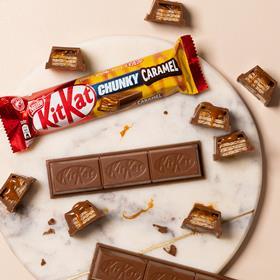
4. Nestlé
2022’s rank: 3
Sales: £1,165.1m (+1.7%)
After big losses in last year’s report, Kit Kat has bounced back for Nestlé. It’s shifted an extra 8.9 million units after debuting on-trend Caramel and Biscoff variants for its Chunky spin-off. A full year of on-the-go and lunchbox occasions sales helped, too.
That’s also the case for Lindahls Kvarg, which sold 6.6 million more packs of yoghurt.
These are the sort of gains that helped mitigate losses for Nestlé elsewhere, keeping overall unit decline to 2.3%.
Its three biggest cereal lines – Cheerios, Shreddies and Shredded Wheat – saw 4.3 million fewer packs go through tills as more workers returned to offices. Quality Street also took a hit, shifting 3.2 million fewer tubs (which shrank for the first time in three years).
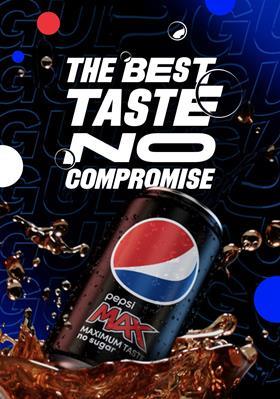
5. Pepsi Cola
2022’s rank: 5
Sales: £777.5m (+8.3%)
Pepsi has outpaced Coke (2) in percentage terms. Value’s up £59.7m after growing volumes 2.1%. That’s an extra 8.2 million packs of cola.
Its most popular range, sugar-free Pepsi Max, has grown value 10% – having “taken advantage of the trend for healthier products”, says Ben Parker, retail commercial director at distributor Britvic.
Pepsi Max Lime, added in May 2021, was a key growth driver, with value up 103% in the year to 28 January 2023.
Now worth £22.7m, it underlines the importance of NPD, says Parker. “With Pepsi Max flavours accounting for 60% share of flavoured cola, with sales worth £179.8m, it is vital for us to continue meeting the demands of health-conscious consumers.”
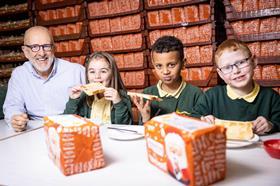
6. Warburtons
2022’s rank: 6
Sales: £757.2m (+6.4%)
With wheat and gas prices soaring due to the Russian invasion of Ukraine, Warbies has been forced to pass on costs to shoppers. As such, average pack price has risen 9.1% – and translated into an extra £45.5m for the brand.
It’s now working to limit further increases, as was shown in January when it cut the breads in Soft Pittas from five to four, while keeping the rsp at £1.49. The aim was to “keep this popular product at an affordable price”. That popularity is illustrated by a 122.6% surge in volumes.
It’s a highlight for the brand alongside the April 2022 launch of The Warburtons Foundation, which has already donated more than 1.5 million products via food banks and breakfast clubs.

7. Heinz
2022’s rank: 7
Sales: £726.8m (+3.8%)
Heinz became an exemplar of food inflation in 2022, amid its high-profile dispute with Tesco over pricing.
The clash left the retailer’s shelves empty of Beanz and Tomato Ketchup products in the summer. But it didn’t stop prices rising.
By the end of the year, the brand’s portfolio was 24.9% pricier on average.
Even more rises were driven through in January, leading Tesco chairman John Allan to imply on live radio that Heinz had been profiteering.
This appears to have taken its toll on unit sales. They’re down 16.8%, driven by the likes of Beanz (–24.1%), canned soup (–15.4%) and Ketchup (–18.4%). Seriously Good Mayonnaise bucked the trend with a 3% uptick.
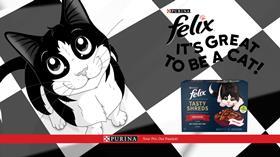
8. Purina
2022’s rank: 8
Sales: £688.9m (+16.6%)
Higher prices continue to drive the majority of value gains for Purina. While volumes rose a steady 4.1%, average price per pack rocketed 12% – banking an extra £97.9m.
This was in part down to shoppers pampering their fur babies by filling their baskets with “more premium products”, says Purina UK&I development organisation director Ben Duncan.
As such, the brand relaunched its premium Gourmet Mon Petit pouches last May, boasting a “new intense flavour” and improved recyclability.
For Felix – Purina’s most popular brand – a focus on driving trade-up from entry-level lines to its premium As Good As It Looks range has brought in an extra £12.3m.
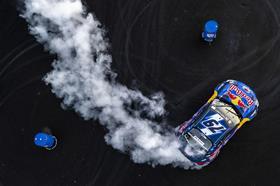
9. Red Bull
2022’s rank: 11
Sales: £577.0m (+15.2%)
Britain’s biggest energy drink brand continues to charge ahead, having put an extra £76m through tills. It also shifted 35 million more packs – a rise of 12.3%.
Given that 70% of its sales are for immediate consumption, it’s clear Red Bull benefited from the first full year free of Covid restrictions as on-the-go made a comeback.
Innovation also played a crucial role. The brand points to its Apricot Edition, which has sold 4.5 million packs and amassed £6.4m since launching in March, as instrumental to the brand’s success.
Sales of the larger flavoured Edition range have almost doubled in the past year, she adds. To sustain growth, February saw the launch of Juneberry Edition.

10. Birds Eye
2022’s rank: 9
Sales: £560.8m (–1.5%)
A return to normal shopping habits post-Covid resulted in a slow start to 2022 for Birds Eye.
Over the full year, the Nomad Foods brand suffered value and volume declines of 1.5% and 12.7% respectively. A strong showing in Q4, however, suggests an imminent turnaround in its fortunes, says Birds Eye marketing director Jim Shearer.
He expects the cost of living crisis to result in an uptick in frozen sales, “as we see the role of frozen becoming more important than ever in shoppers’ lives”.
“Frozen food has always played an important role in helping shoppers get more for their money, offering longer shelf-life and easy portion control, which in turn can help reduce food waste, allowing budgets to stretch further,” Shearer explains.
Furthermore, frozen’s convenient nature “will really come to the fore” during tough times, he adds.
That should help deliver a much-needed boost to its everyday lines. While peas are down £5.5m, fish fingers have fallen £0.9m (however, potato waffles are up £2.5m).
To maintain interest in its trendier lines, too, the brand has been spending on marketing and innovation.
The meat-free Green Cuisine brand relaunched with a £4.4m push, ‘Welcome to the Plant Age’, in July.
It demonstrated how “easy, delicious and nutritious it can be to incorporate plant-based options into everyday meals”, says Shearer. That activity was supported by NPD like Fishless Fillets.
World cuisine was another focus of Birds Eye’s attention. In August, it expanded its chicken lineup with variants “inspired by the tastes of Italy and Mexico”.
As a brand with heritage, says Shearer, Birds Eye is “in a great position to offer consumers the reassurance they’ll be seeking” at this time.

11. Kellogg’s
2022’s rank: 10
Sales: £518.9m (+1.4%)
Value growth of £7.1m masks a harsh reality for Kellogg’s: as the cost of living crisis rages, branded cereal sales are going soggy. The brand’s overall units have sunk by 4.6 million packs – a decline of 1.9%.
Coco Pops suffered most, with a decline of £5.8m. It’s crunch time for Crunchy Nut, too. The core cereal has lost £4.6m, while its Clusters spin-off is £2.5m poorer.
Still, it’s not all bad. The revival of on-the-go snacking helped Rice Krispies Squares make an extra £10m.
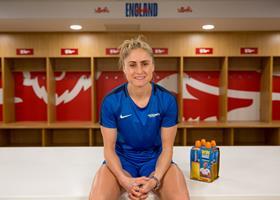
12. Lucozade
2022’s rank: 14
Sales: £517.4m (+15.4%)
Lucozade has racked up an extra £69m on volumes up 6.6%, thanks to the return of on-the-go occasions.
Notably, its Sport range is up 33% in value and Energy has grown 9.9%, while September 2021 launch Alert is already worth £9.1m. The brand is “proud of the performance in a difficult and changing market, including internal challenges such as rising costs,” says sales director Jon Plows.
Lucozade kicked off 2023 with a TV ad for Sport featuring an animated statue.
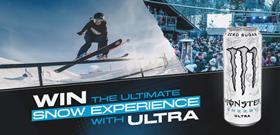
13. Monster
2022’s rank: 15
Sales: £500.1m (+18.6%)
Monster is sharpening its claws as it gets closer to the top 10, widening its range and upping marketing and on-pack promotions.
This year the brand has finally smashed the £500m barrier thanks to the sharpest percentage gain in this report’s top 20, on units up 14.7%. The Juiced and sugar-free Ultra ranges contributed most to Monster’s £78.5m growth, adding £33.3m and £30.4m respectively.
Now a move into seltzers could soon be on the cards.
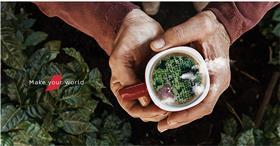
14. Nescafé
2022’s rank: 12
Sales: £465.5m (+0.1%)
Britain’s leading instant coffee stayed in the black thanks to a 9% rise in average pack price. Volumes fell 8.2% in the face of a full recovery for coffee shops.
In response to the shift in channels, the brand unleashed barista-style innovation to lure “younger, more affluent shoppers”. It teamed up with London roastery Perky Blenders on “a premium craft coffee in instant format” for Azera and added Gold Salted Caramel Mocha, its “most successful coffee NPD of 2022”.
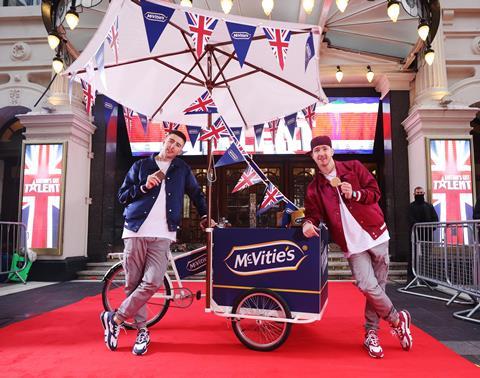
15. McVitie’s
2022’s rank: 13
Sales: £459.7m (–0.4%)
McVitie’s modest £1.7m loss is a significant improvement on the £41.1m decline seen in last year’s report.
However, this is solely due to higher pack prices, up an average 13.5%. Volumes have fallen 12.2%, equating to 44.8 million fewer packs.
Nevertheless, owner Pladis remains optimistic. “While we did see a small value sales decline, put into perspective and against a backdrop of branded grocery overall, this is not out of line with the status quo,” says chief marketing officer Aslı Özen Turhan.
Plus, the biscuit giant enjoyed a period of “solid growth” in October on the back of its biggest push to date, she adds. A £10m campaign included a high-profile partnership with ITV’s Britain’s Got Talent.
That exposure followed an ambitious NPD push by McVitie’s.
Most prominently, it unveiled Blissfuls – indulgent mini biscuits targeted at evening snacking – and revived “popular noughties” sub-brand BN “to drive sales among a wide range of family shoppers”. Together, they raked in £14.6m in a year.
McVitie’s’ non-HFSS takes on standard lines, however, have so far made less of an impact. Rich Tea Delight and Digestives Wholesense – launched in March and June respectively – are worth just £1.8m combined.
“Our strategy last year was all about helping retailers offer shoppers choice,” says Özen Turhan.
“This meant offering a range that appeals to shoppers looking for an indulgent treat, alongside lighter propositions.”
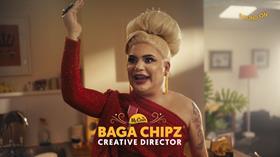
16. McCain
2022’s rank: 16
Sales: £419.8m (+0.7%)
Summer was a mixed bag for McCain. In June, it was forced to switch to a blend of oils amid sunflower oil shortages. In the same month, however, the brand raised smiles by appointing RuPaul’s Drag Race UK star Baga Chipz as creative director.
The partnership for the ‘Anything Goes’ push came as Brits invested in money-saving air fryers. In response, McCain “refreshed our packaging to show that our products are air frier-friendly”, says marketing director Mark Hodge.
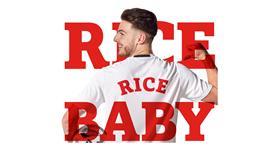
17. Müller
2022’s rank: 19
Sales: £409.5m (+6.5%)
After several years of decline, Müller has returned to growth. That’s partly down to a 13% rise in average price. But its core milk – which relaunched last April with a new pack design stressing health, recyclability and responsible sourcing, and bagged new listings – grew volumes by 27.4% and value by £23.4m.
Müller’s salted butter also saw massive growth – up £6.4m to £9.7m – while new lines Gut Glory, Müller Rice Chocolate and Müller Rice Protein added a total £3m.
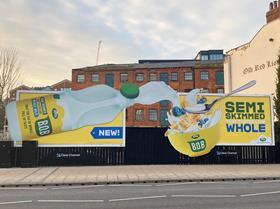
18. Arla
2022’s rank: 18
Sales: £408.0m (+4.8%)
Arla points to consumer cutbacks in consumption – driven by the cost of living crisis – as the main driver of its 8.1% slump in volume. It’s sold 21.2 million fewer units.
The likes of Cravendale and Lactofree, in particular, suffered hefty hits to volumes.
Still, other smaller ranges look buoyant – such as Protein Yoghurt, which has shifted 6.7 million more packs.
And Arla has still managed to net an £18.7m value gain, thanks to a 14.1% increase in average pack price.
![11698103_Andrex_Heritage_CIAF_3130x2008px_RGB[8]](https://dmrqkbkq8el9i.cloudfront.net/Pictures/480xany/2/8/7/289287_11698103_andrex_heritage_ciaf_3130x2008px_rgb8_163296.jpg)
19. Andrex
2022’s rank: 22
Sales: £400.5m (+11.7%)
“A continued focus on quality” in innovation and marketing has helped Andrex maintain post-pandemic sales, says owner Kimberly-Clark.
While a 10.8% rise in average pack price has been crucial to the brand’s extra £42.1m, that figure was also down to a 1.4% rise in units. That’s a respectable gain given the wider decline across higher-end loo roll brands.
Kimberly-Clark points to the summer launch of the wallet-friendly Classic Clean Mega Roll – promising to last 50% longer while providing “the same great clean” – as a highlight. And, as part of Andrex’s overall mission to become more sustainable, Mega Roll’s packaging uses at least 30% recycled material.
Premium cues have also been a focus of the brand’s NPD. In early 2022, it unveiled its “softest ever” toilet tissue: Ultra Care with aloe vera soothing lotion.
It was prompted by “continued growth of the added benefit and quilted segments”, says Kimberly-Clark.
Smaller packs of six rolls, aimed at families on a weekly budget, have now been added, too. They landed last month to cater for the expectation that shoppers will “buy smaller pack formats more frequently, rather than buying into extra-large packs”.
To drive home its wide range of innovation, Andrex spent £5m on advertising in 2022 – covering TV, press, digital, social media and in-store activations.
Coinciding with the brand’s 80th anniversary, the ‘A Little Love Goes A Long Way’ campaign offered the chance to win a cuddly toy version of the Andrex puppy mascot.
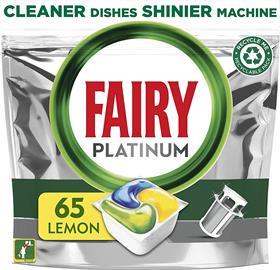
20. Fairy
2022’s rank: 20
Sales: £386.9m (+7.0%)
An extra 1.4 million packs of Fairy have gone through the tills. While its core washing-up liquid performed modestly – due to the decline in dishwashing occasions at home – its laundry lines benefited from a revival of the category.
Non Bio, for example, sold 572,000 more units after a summer relaunch in “a ground-breaking and innovative Ecoclic cardboard pack”.
And Fairy Outdoorable fabric conditioner, added in October, earned £1.9m in its first two months.
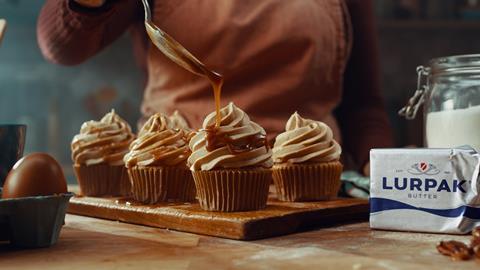
21. Lurpak
2022’s rank: 17
Sales: £374.7m (–4.0%)
Lurpak made headlines last summer as social media users recoiled at the prospect of paying up to £7 for a 750g tub. It’s unclear what – if any – impact this had on the market-leading brand’s sales.
But what’s certain is units fell 19.1%. While an 18.6% rise in average pack price mitigated value decline, Lurpak was unable to avoid a £15.7m loss as Brits shopped BSM less frequently or traded down.
It comes after a “difficult year” of trading for owner Arla, according to group CEO Peder Tuborgh in the dairy co-op’s recently published accounts. It reported a 7% slump in overall branded volumes, and named Lurpak as a key driver of this decline.
NIQ’s read backs this up: most of the brand’s main variants are shown to have shed units in the past 12 months. Most notably, the bestselling Spreadable Slightly Salted suffered a 15.8% dive.
Tuborgh believes 2023 will “undoubtedly be another difficult year”.
The supplier expects to see “a continued slowdown in branded growth due to reduced buying power of consumers”, he said in the report.
Arla Foods UK director of BSM Stuart Ibberson is somewhat more optimistic.
Lurpak remains the “first-choice consideration among consumers”, he says. He points to lines such as Butterbox in a 100% recyclable pack, which “has continued to drive incremental buyers to the category”.
Lighter Block, meanwhile, is particularly popular among 16 to 34-year-olds. So, attracting younger shoppers to butter & spreads is one challenge Lupak has overcome, at least.
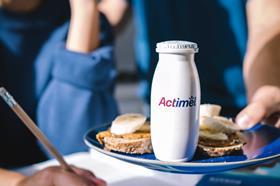
22. Danone
2022’s rank: 21
Sales: £370.2m (+2.9%)
Danone will never launch HFSS products for kids, it pledged last month.
The supplier’s commitment to healthier yoghurts and yoghurt drinks is already apparent by 90% of its volume sales coming from HFSS-compliant lines, it says.
Those volumes, however, are currently down 5.5% – or 10.7 million packs.
That follows the £1m summer push for Light & Free, ‘Light Never Less’, stressing that low-fat products can still offer taste and texture.
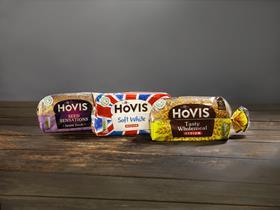
23. Hovis
2022’s rank: 24
Sales: £352.6m (+3.4%)
Hovis has moved up the ranking despite falling victim to the continued decline in wrapped bread volumes, selling 26.9 million fewer packs.
But a 13.6% rise in average price supported value. And there were bright spots: Hovis Soft White was the biggest contributor to prepackaged bread in 2022, it says. Its premium Hovis Bakers Since 1886 range, added in April 2021, is now worth nearly £13m.
Other recent NPD has included hot dog rolls, home bakes and teacakes.
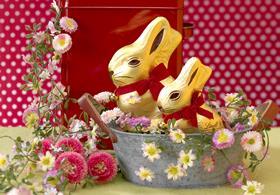
24. Lindt
2022’s rank: 23
Sales: £339.3m (–2.2%)
The fastest-growing chocolate brand of 2022 was entirely buoyed by a 7.4% increase in average price. Unit sales are down to the tune of 8.9%.
The decline is due in part to a scorching summer that stymied appetite for the likes of Lindt’s Lindor balls and Excellence bars.
Festive sales either side of the heatwave were more encouraging. At Easter, an extra 359,400 Gold Bunnies went through tills, while Christmas helped shift 422,400 more Gold Teddies.
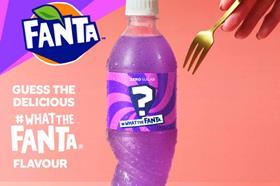
25. Fanta
2022’s rank: 30
Sales: £292.3m (+19.7%)
Lilt’s headline-making demise last month also won publicity for its replacement: Pineapple & Grapefruit Fanta.
It came at a time of soaring sales for the brand. It’s up 10% in volumes – equating to 16.4 million extra packs – and £48.1m in value.
This was assisted by savvy marketing including its third #whatthefanta push. Fanta also marked Halloween with a TV ad and on-pack promotion – and it teamed up with Mentos to launch Fanta-flavoured chewy sweets.
26. Pringles
2022’s rank: 28
Sales: £284.0m (+7.3%)
Here’s an example of how the new HFSS regulations are driving a wave of innovation in savoury snacking.
Pringles has added £19.2m to its top line on unit sales up 5%, after unveiling the three-strong, HFSS-compliant Multigrain range in September.
Last month saw the launch of a TV ad featuring a keyboardist hamster playing ambient techno, to plug Multigrain’s Roast Chicken & Rosemary, BBQ Sauce and Sour Cream & Chilli variants.

27. Robinsons
2022’s rank: 27
Sales: £267.5m (+0.4%)
Units of Britain’s biggest squash brand have been diluted by a full year of no lockdowns. Its 4.8% slide, however, is masked by £1.1m growth driven by higher average pack prices.
Britvic retail commercial director Ben Parker says some consumers “feeling the pinch” have been trading down. To accommodate this, Robinsons is focusing on its ‘good, better, best’ strategy, bringing new lines across its core squash, mid-tier Fruit Creations and posh Cordials ranges.
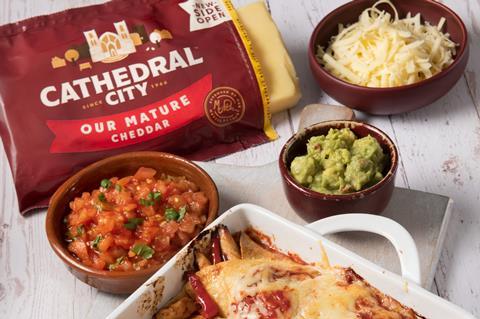
28. Cathedral City
2022’s rank: 25
Sales: £267.5m (–4.8%)
Like many other cheese brands, Cathedral City has struggled. It’s suffered a 15.8% fall in volumes – the equivalent of 17.4 million packs of cheddar. This is primarily down to shoppers facing “a squeeze on disposable income during the cost of living crisis” and trading down to own label, says owner Saputo.
In a bid to reverse this decline, Britain’s biggest cheese brand has increased its focus on innovation. Most significantly, it’s tapped the veganism mega-trend with its first plant-based variant. Added in September, Cathedral City Plant Based followed Saputo’s May 2021 acquisition of vegan ‘cheese’ pioneer Bute Island Foods.
The launch has “exceeded expectations and went down a storm with consumers, who hailed the range as a game-changer for non-dairy alternatives thanks to its taste, texture and meltability”, says Cathedral City marketing controller Neil Stewart.
That’s reflected in a “strong sales performance, with people going out of their way to get their hands on the products when it first launched in Tesco”, he adds.
Cathedral City Plant Based has since bagged listings with Sainsbury’s, Asda, Morrisons, Ocado and Amazon Fresh.
That SKU also sports the revamped packaging design introduced across the Cathedral City portfolio in May – its first makeover in six years. The following month, the brand mounted a £5m push and gave its packs a sideopening designed to save 40 tonnes of plastic a year.
Sales may be down, but Cathedral City is clearly upping its innovation.
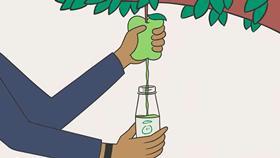
29. Innocent
2022’s rank: 26
Sales: £256.5m (–7.7%)
Innocent has had a shocker, haemorrhaging £21.5m – the third-biggest absolute loss in this report. It sold 16.1 million fewer packs of juices and smoothies, representing a unit decline of 11.9%.
It comes after a TV and online ad trumpeting the brand’s eco-credentials – under the slogan ‘Little Drinks, Big Dreams’ – backfired. In February 2022, the ASA found Innocent guilty of greenwashing for misleading shoppers over the environmental benefit of products.

30. Doritos
2022’s rank: 33
Sales: £252.2m (+14.2%)
PepsiCo’s tortilla snack brand has delivered a £31.3m gain – but units are up just 1%, or 1.8 million packs.
This is partly explained by a 9.9% surge in sales of bigger and higher-priced sharing bags, says Doritos marketing director Lee Houston. “Larger sharing formats have consistently driven category growth and are now the biggest format in savoury snacks.”
That’s largely due to the rise of big nights in for gen Z shoppers, he adds. Hence the latest ad focused on such occasions.
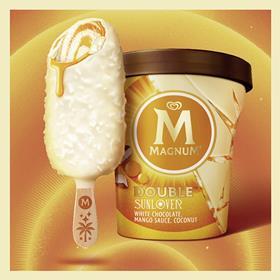
31. Magnum
2022’s rank: 31
Sales: £238.9m (+1.4%)
“Premium indulgence still plays a key role in ice cream,” says Unilever head of ice cream Jennifer Dyne. To fully capitalise, Magnum last year spent £10m on a rebrand for its core lollies and added the Remix range of “supercharged” handhelds.
Still, volumes fell 8.7% following the highs of 2021. So the brand has kicked its efforts into higher gear. Indulgent Double Starchaser and Double Sunlover lines landed in January – soon to be backed by an £11m push.

32. Wrigley’s
2022’s rank: 36
Sales: £235.0m (+19.7%)
Wrigley’s – Britain’s biggest name in sugar confectionery – is in fine fettle. Its £38.8m growth makes it the joint-fifth fastest riser in the top 100, alongside Fanta.
That’s down to selling 23.8 million more packs of gum to Brits on the go.
The Extra sub-brand accounted for the bulk of overall sales. Owner Mars Wrigley pointed to “exciting product innovation” – such as Apple and Blueberry variants – as a key driver alongside “a fresh new look”.
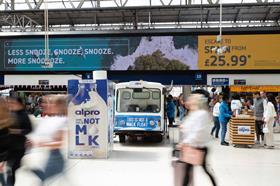
33. Alpro
2022’s rank: 29
Sales: £231.7m (–9.1%)
Alpro started the year strong with the launch of its “closest match to dairy milk” range. Not M*lk, an oat-based dairy alternative, hit shelves in January and received its own campaign over the summer.
However, “production challenges” at one of its factories led to gaps on shelves for its soya drinks in September. At the same time, Alpro lost share to challengers and own label.
This contributed to a 16.4% fall in unit sales – only partly mitigated by an 8.7% rise in average price per pack.

34. Galaxy
2022’s rank: 32
Sales: £222.7m (–2.8%)
It’s fair to say 2022 was rather eventful for Galaxy, which suffered a £6.5m loss as volumes sank 4.8%.
The year began with a bang for the brand, which was included in owner Mars Wrigley’s high-profile debut in non-HFSS confectionery.
Unveiled in May, the Triple Treat lineup comprises healthier takes on Galaxy, Mars, Snickers and Bounty bars – all at a higher price point than the standard versions.
Matters took a downturn the following month, however, when Galaxy was among the Mars brands to have their vegan lines delisted by Tesco, Sainsbury’s and Morrisons.
To make matters worse for Galaxy, it was then usurped by Lindt Lindor as Britain’s second-biggest chocolate brand, as revealed by The Grocer in September.
This preceded a reformulation in which skimmed milk powder replaced cocoa butter as the second-largest ingredient after sugar across a wealth of Galaxy lines. Mars remained tight-lipped about the reason for the change.
But the supplier was more forthcoming in December, when it unveiled Galaxy chocolate digestives – designed to tackle the “extremely limited” branded choice.
Not content to rest on its laurels after a hectic 12 months, Galaxy is now gearing up for the latest leg of “a journey to inform consumers of the work we are doing to support women in our cocoa-growing communities”, says brand director Victoria Gell. A new push, set for this month, will share the women’s stories “and our commitment to helping women, their families and communities thrive”.
![Haribo_Police_Still_002[2]](https://dmrqkbkq8el9i.cloudfront.net/Pictures/280xAny/3/1/1/289311_haribo_police_still_0022_985534.jpg)
35. Haribo
2022’s rank: 39
Sales: £220.7m (+17.5%)
Innovation has been a key driver of Haribo sales – helping push an extra 22.3 million packs through the tills and adding £32.8m in sales.
Most notably, the brand boosted its sour offer with Soda Twist Zing and added Balla Bites to its vegetarian options. It also invested in new seasonal products such as Monsters Zing and Sour Skeletons for Halloween.
“We are grateful that the nation’s sweet lovers continue to choose our products,” says Haribo UK&I MD Jon Hughes.

36. Maltesers
2022’s rank: 37
Sales: £201.2m (+2.9%)
Maltesers, says brand director Leah Dyckes, is “loved by consumers”. She points to the popularity of Maltesers’ novelty self-eat shapes, such as Orange Chocolate Bunny.
Thanks to confectionery shoppers “always looking for fun, seasonal variations and new flavours”, the 29g countline “was very popular last Easter. It grew 46% vs 2021.”
Maltesers’ sharing bag, on the other hand, shrank in the summer – from 189g to 175g – while its price remained the same.
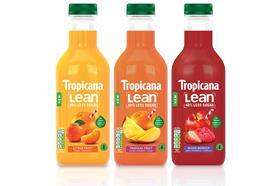
37. Tropicana
2022’s rank: 34
Sales: £200.4m (–5.4%)
Tropicana’s £11.4m loss leaves the brand’s value below the £208.8m we reported just as Covid hit the UK. And volumes have plunged 11.4% – or 12.4 million packs.
Still, the fruit juice brand remains upbeat, insisting it’s declined slower than the overall category.
Tropicana attributes this relative success to being a “strong brand” that encourages repeat purchase. Its breadth of products creates a “well-rounded and strong connection with customers”.
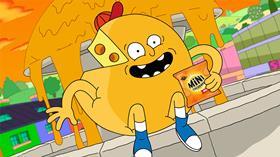
38. Jacob’s
2022’s rank: 35
Sales: £196.2m (–2.1%)
New lighter Mini Cheddars variant Nibblies and the return of the ‘Welcome to Cheddar Town’ TV ad put an end to the major declines suffered by Jacob’s last year, it says. Higher prices also helped keep value losses to £4.2m as volumes plunged 13%.
That volume fall was in small part down to workers at Jacob’s Aintree factory walking out over pay in November, leaving supermarket shelves devoid of Cream Crackers and other savoury biscuits in the run-up to Christmas.
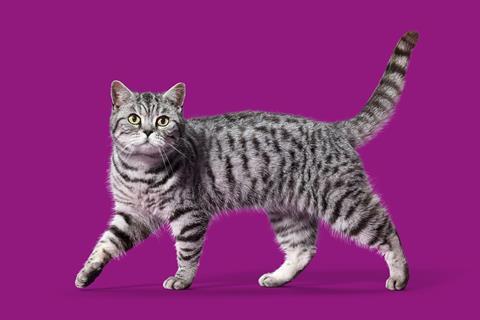
39. Whiskas
2022’s rank: 44
Sales: £187.0m (+6.6%)
Heinz (7) wasn’t the only big supplier in a high-profile row with Tesco last summer. Mars Petcare also got into a spat with the retailer over pricing. The Whiskas and Pedigree (48) owner paused supply, leading to gaps on shelves in Tesco’s petfood aisle.
It’s likely this contributed to Whiskas’ humdrum performance. Armen Topalian, sales director at Mars Petcare, points out the brand’s year-on-year value was 16.4% up in May 2022 [NIQ] – ahead of the tiff with Tesco.
However, Whiskas ended the year just £11.7m in the black – and thanks only to a 22.7% rise in average price per pack. Volumes are down 13.1%. That’s the fastest units decline of any petcare brand in this report – equivalent to 7.6 million fewer packs through supermarket tills.
Still, Topalian is confident Whiskas can still enjoy “positive momentum” – driven in part by a brand shake-up.
“We recently relaunched Whiskas and rolled out a new portfolio of wet food pouches, as well as refreshing our dry, canned and care & treat ranges,” he says, highlighting three new varieties of wet pouch meals: Favourites, Duo and Tasty Mix.
“Favourites is made with single proteins, Duo offers pets ultimate enjoyment with two delicious flavours in each pouch, and Tasty Mix contains a tantalising mix of ingredients for more variety,” Topalian adds.
Their addition means Whiskas’ portfolio of recipes has more than doubled, from 10 to 25. Coupled with new pack designs, he’s certain they “will strengthen the proposition of the range”.
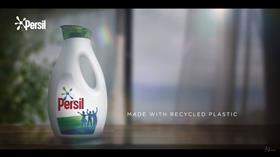
40. Persil
2022’s rank: 48
Sales: £186.1m (+13.0%)
Persil’s been premiumising. Its £21.4m gain comes after launching Ultimate non-bio laundry detergent with aloe vera (rsp: £8/34 washes).
Added in March, Persil’s “toughest non-bio for stain removal” has since introduced Active Clean and Touch of Comfort variants.
They’re on shelf alongside new 3-in-1 laundry pods made from 65% plant-derived ingredients. They rolled out this month in plastic-free packaging, after being unveiled with some ceremony in July 2022.

41. Weetabix
2022’s rank: 40
Sales: £186.1m (+0.4%)
Britain’s biggest cereal brand was given a boost in early 2022, when – for the second year running – it went viral on social media as TikTok users posted their takes on chilled ‘overnight Weetabix’.
This was followed in the spring by a team-up with Lyle’s Golden Syrup for breakfast biscuits that were sweetened but still non-HFSS.
These were the sort of events that helped limit unit declines to a relatively low 5.6% as cash-conscious shoppers traded down.

42. Young’s
2022’s rank: 41
Sales: £183.9m (–0.4%)
Young’s felt the return to pre-pandemic habits, seeing units fall 9.7%. However, thanks to price rises, value barely changed – and it’s still 7% up on 2019, the brand points out.
It expects to see Brits this year “increasingly turning to frozen seafood as they look to manage their budgets during the cost of living crisis”.
So, to tap the rise in at-home meals, Young’s last year expanded its Gastro brand to offer “the feelgood factor of going out”. More of the same can be expected soon.

43. Volvic
2022’s rank: 50
Sales: £180.7m (+11.8%)
In August, c-store retailers complained of a shortage of Britain’s best-known bottled water brands, including market leader Volvic.
Driven by a combination of manufacturing and logistical issues, labour shortages and heightened demand due to hot weather, it forced some wholesalers to put caps in place to control stock.
That was the only dampener in an otherwise glorious summer for the category, with the heatwave helping Volvic shift 2.4 million extra bottles.
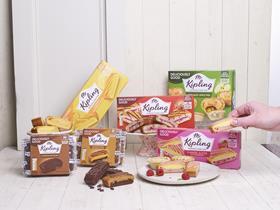
44. Mr Kipling
2022’s rank: 53
Sales: £178.9m (–0.3%)
Mr Kipling has just about managed to hold on to its value. But that’s down only to its average price per pack soaring 20%.
The brand admits volumes – down 16%, or 24.7 million units – were affected by “lower promotional activity and price elasticity”.
However, it has plans to revive growth through “strong consumer support” and a steady stream of NPD, which last year included its HFSS-friendly Deliciously Good cake range with 30% less sugar.
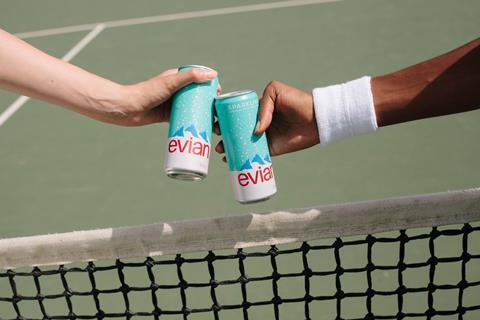
45. Evian
2022’s rank: 57
Sales: £176.0m (+15.8%)
The bottled water market has regained its mojo. All four dedicated brands in this report are in double-digit value growth – adding a combined £122.5m.
Evian is responsible for £24m of that figure. The brand has shifted an extra 6.3 million packs, and not just thanks to record-breaking temperatures last summer and the return of the on-the-go trade.
While Evian admits the surge of on-the-go sales has accelerated performance, it also says consumers are drinking more water as part of a growing focus on health.
NPD has played a part, too. Evian names its sparkling water as a significant driver of growth last year. The launch of a 330ml can in January 2022 tapped increasing demand from convenience shoppers, says the brand, which has since added a one-litre bottle of sparkling water for the at-home market.
The can’s launch – supported by a push with the tagline ‘We’ve added sparkles’ – has seen Evian become the UK’s fourth most popular sparkling water brand, it adds.
For the brand’s larger portfolio, Wimbledon was a key occasion last year.
The return of capacity crowds and 100 years of centre court was celebrated by Evian – the official water of the tennis competition – via a bespoke bottle for the players.
Additionally, a recycling reward scheme – ‘Return4Reward’ – was trialled at Wimbledon. By scanning both the QR code on recycling points and the barcode on Evian packs, tennis fans could enter a draw to win tickets to Wimbledon 2023.
Looks like Evian’s served an ace.
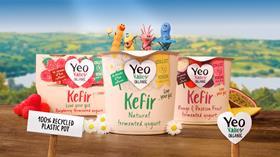
46. Yeo Valley
2022’s rank: 46
Sales: £174.7m (+4.2%)
Despite Yeo Valley suffering a 5% decline in volume, the past year still featured “many memorable moments”, says brand director Niall McKee.
These included a first move outside dairy. Fresh soups and dips added in September were part of a strategy to inspire shoppers to “make healthier, more sustainable food choices” by expanding availability of organic products in the major supermarkets.
That was preceded in August by the addition of Yeo Valley’s first drinking kefir.
47. Schweppes
2022’s rank: 38
Sales: £172.9m (–8.4%)
A £15.8m loss on units down 14.9% hardly seems worth toasting. Until, that is, the results compared with the dismal fortunes of posh rival Fever-Tree (97).
Indeed, with the brand’s tonics up to £103.5m, it’s overtaken Fever-Tree to reclaim the crown of Britain’s biggest mixers maker.
Schweppes owner CCEP puts its performance down to “behaviours returning to pre-Covid norms” as pubs enjoyed their first full year with no lockdowns since 2019.

48. Pedigree
2022’s rank: 48
Sales: £172.7m (–4.4%)
With the dog ownership craze slowing, Pedigree could’ve done without being pulled from Tesco shelves last summer. While the move – the result of a pricing dispute between the grocer and brand owner Mars Petcare – was temporary, it no doubt contributed to an 11% fall in units.
Pedigree is now looking to broaden its appeal, having made its supplements debut with a range of multivitamins. It’s also premiumised its offer with NPD such as Ranchos Lastin’ Layers treats.
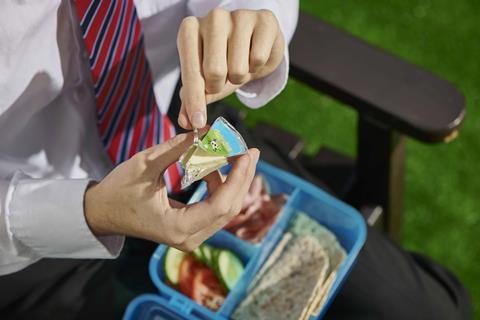
49. Dairylea
2022’s rank: 58
Sales: £170.1m (+13.1%)
Not only has Dairylea amassed an extra £19.7m, it’s also enjoyed volume growth of 10.8%. That’s a sterling comeback for the brand, which suffered a major slump during Covid lockdowns.
Owner Mondelez attributes the latest performance to “families returning to busy, on-the-go routines and selecting Dairylea for these snacking needs”. This is especially significant given the brand has more than 50% penetration of households with families, according to the supplier.
Brand loyalty has been a key factor to thriving in the cost of living crisis. Mondelez points to internal research showing 67% of shoppers would “rather buy fewer amounts of their favourite snack brand, than buy the less expensive generic alternative”.
To cement its status as a favourite snack, Dairylea last year bagged listings across the mults for its Filled Crackers, launched in autumn 2021. The snack performed “brilliantly” in consumer testing, says Mondelez trade communications manager Susan Nash.
It came top of the lunchbox concepts tested by NIQ. As many as 88% of respondents to its survey agreed the product was “a great brand fit to give families a tasty snack with their lunch or after school”, Nash adds.
To support its portfolio, Dairylea kicked off the latest iteration of its ‘Set Them Free’ campaign in August – this time, starring two kids asking why Dairylea portions are triangular. The push, says Nash, “celebrates curiosity and playfulness and strengthens the brand’s purpose of helping parents and guardians champion pure childhood”.
![Charlie Bigham BG11421_KH_LS_CHICKEN_MADRAS_150621_087_RET (1)[33]](https://dmrqkbkq8el9i.cloudfront.net/Pictures/280xAny/3/5/9/289359_charliebighambg11421_kh_ls_chicken_madras_150621_087_ret133_666473.jpg)
50. Charlie Bigham’s
2022’s rank: 46
Sales: £169.1m (+10.2%)
Bigham’s continues to run circles around its ready meal rivals. While value growth has slowed since last year, it’s still up £15.6m – having shifted one million extra units.
The brand was well placed to capitalise on shoppers looking for a cheaper, yet equally enjoyable alternative to dining out. “Having a Charlie Bigham’s meal in the fridge means consumers can still have a night off cooking without the expense of a takeaway or restaurant,” says CEO Patrick Cairns.
51. Starbucks
2022’s rank: 53
Sales: £168.7m (+8.0%)
In spite of the resurgence of coffee shops last year, demand remained steady for Starbucks’ retail range. Volumes fell just 0.4%. To capitalise, the brand debuted Nespresso-compatible Breakfast Blend pods and two 750ml RTDs, and relaunched its instant Premium Mix.
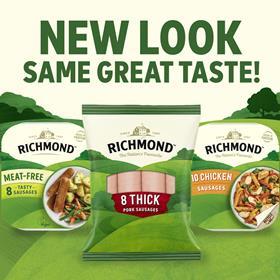
52. Richmond
2022’s rank: 49
Sales: £164.7m (+0.8%)
After strong showings in recent years, Richmond’s units have fallen 5.2%. But marketing controller Chris Doe insists it’s going “from strength to strength”. He says the brand is “flexing beyond its roots in meat to become a heavyweight in meat-free” – in which it’s now a top three player.
53. Lenor
2022’s rank: 52
Sales: £162.1m (+0.6%)
Lenor’s units fell 5.3% last year, as the brand was highlighted as an example of shrinkflation in laundry. Its Fabric Conditioner Ruby Jasmine Scent 1.75l, for instance, was replaced by a 1.68l version. However, owner P&G says its Outdoorable lineup has “made headway”.
54. Quaker
2022’s rank: 56
Sales: £158.7m (+4.1%)
Quaker’s looking healthier. “After extensive reformulation across the range in 2022, we’re proud that all but one of our products are now non-HFSS,” says GM Divesh Parmar. It also added compliant Chocolate Orange and Caramel Fudge Heavenly Oats pots, helping drive a £6.3m gain.
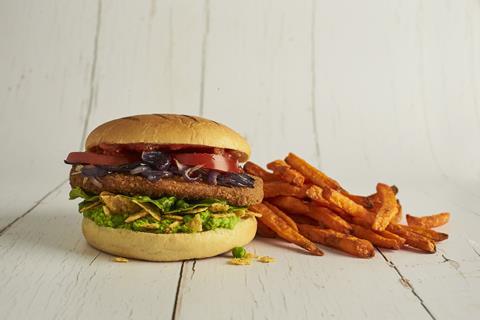
55. Quorn
2022’s rank: 47
Sales: £158.3m (–5.5%)
While Quorn is still the biggest name in meat-free, its dominance of the market continues to weaken under pressure from smaller rivals.
Volumes have fallen 11.2% – but the brand reckons its “high level of trust and loyalty” will ensure it remains in shopping baskets even as purse-strings tighten.
“We’re the beacon brand within the category,” says Gill Riley, Quorn Foods UK marketing director. “This is proving to be vitally important as the nation navigates turbulent economic times.”
While health and sustainability continue to be key purchase drivers for the brand, value for money is becoming an “even more important consideration”.
With that in mind, Quorn last year added larger pack sizes so “shoppers can be easily reassured they’re getting great quality and value for money”. And it grew its Takeaway range to enable families “to replicate their favourite takeaway or fast food at home to save money”.
In further efforts to shore up sales, Quorn also targeted new audiences. It added a deli range aimed at those working from home, and it overhauled its £1.3m range of on-the-go sandwich fillers.

56. Kinder
2022’s rank: 45
Sales: £156.1m (–9.8%)
Just weeks before Easter 2022, Kinder was linked to dozens of salmonella cases and was forced to halt production. Which helps explain its £17m loss – the sixth-largest in this report. Still, the brand remains “well-loved by families”, insists Jason Sutherland, sales director at owner Ferrero.
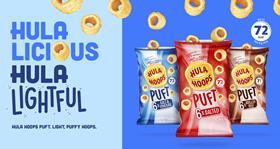
57. Hula Hoops
2022’s rank: 51
Sales: £155.0m (–3.9%)
A makeover and a £1m push have put Hula Hoops on the front foot for the year ahead. The non-HFSS reformulation for Puft will also help drive sales, believes KP Snacks marketing director Kevin McNair. “With health remaining a key priority, the light, low-calorie offer is the ideal choice.”
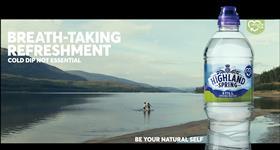
58. Highland Spring
2022’s rank: 79
Sales: £153.5m (+25.3%)
Highland Spring’s grown value at an even faster rate than last year. Its extra £31m was down in part to 2022’s scorching summer, which helped sell 9.6 million more packs. Sales were also buoyed by a TV ad, as well as demand for soft drinks as an alternative to alcohol, the brand says.

59. Ariel
2022’s rank: 54
Sales: £153.4m (–1.6%)
Ariel’s 14% decline in units is, in part, due to concerns about energy costs, says owner P&G. “We are seeing a significant increase in consumers creating fuller loads… to give more time between washes.” But it’s still innovating: in August, it unveiled cardboard packaging that’s eco and easier to open.

60. Dr Pepper
2022’s rank: 72
Sales: £151.4m (+18.2%)
Dr Pepper’s value growth marginally outpaced that of flavoured carbonates overall, the brand says. It’s £23.3m better off after its on-the-go and sharing packs soared 15.5% and 20.4% respectively, while demand for sugar-free drinks helped Dr Pepper Zero grow its value by 20.2%.
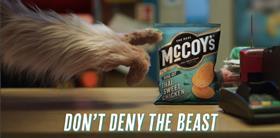
61. McCoy’s
2022’s rank: 59
Sales: £149.9m (+0.1%)
Despite relaunching its ‘Don’t Deny The Beast’ push in 2022, McCoy’s performance lacked bite. A 7.4% drop in units was mitigated only by an 8.1% rise in average price – keeping value flat. New range Epic Eats, added in January, aims “to excite the category and bolster growth of the brand”.
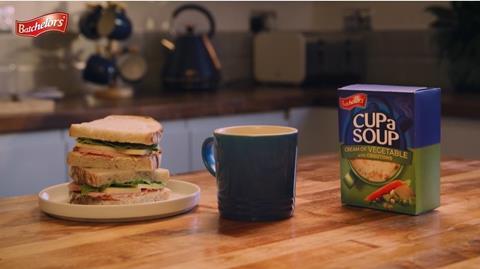
62. Batchelors
2022’s rank: 70
Sales: £146.8m (+13.5%)
Batchelors sales are boiling up almost as fast as its speedy pasta lines. It’s added an extra £17.4m over the past year.
Granted, that figure isn’t quite as positive as it may first seem. Volumes are down 5.1%, meaning growth has come entirely through price rises.
But it’s a solid performance in comparison to its Premier Foods stablemates. Mr Kipling (44) and Bisto (73) have both suffered double-digit hits to volume.
And it’s outright impressive considering Batchelors’ Super Noodles and Pasta ‘n’ Sauce pots were dogged by supply issues last September.
Batchelors says its relative success “reflects its pivotal role in meeting the increased demand for hot home lunches”. The brand also points to its more premium Pasta ‘n’ Sauce Chef Specials – unveiled in September – as another string to its bow.
The brand’s only challenge is just how much shoppers are willing to pay for those SKUs. Average prices across its range have risen just shy of 20% over the past year. And The Grocer this month reported Super Noodles are 52% pricier than they were a year ago.
Whether this affects volumes will be a test of just how much Brits love their noodles.
63. Comfort
2022’s rank: 60
Sales: £146.2m (–1.6%)
While fabric conditioners have seen a “slight decline”, Comfort’s core variants – Blue Skies and Sunshiny Days – have grown value 6.8%. This is thanks to shoppers prioritising fragrance, says Unilever. That has also been a driving force behind its limited-edition seasonal lines, it adds.
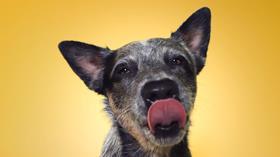
64. Good Boy
2022’s rank: 73
Sales: £143.7m (+12.9%)
The unstoppable Good Boy made its top 100 debut last year. Now the petcare brand’s powered up the ranks further with a £16.4m gain on a 6.2% rise in units. This was aided by new listings across the traditional top four and Waitrose for the likes of its Chompers and Meaty Treaty lines.
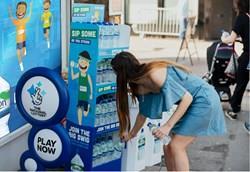
65. Buxton
2022’s rank: 110
Sales: £139.7m (+53.1%)
Record summer temperatures and a return of on-the-go occasions boosted bottled water. But few brands benefited as much as Buxton, which soared £48.4m– the eighth-biggest gain in this report. Volumes soared 35.8%, outpacing bigger rivals Volvic (43), Evian (45) and Highland Spring (58).

66. Anchor
2022’s rank: 68
Sales: £137.9m (+5.6%)
Unlike Arla stablemate Lurpak (21), Anchor has grown value – albeit thanks to a 17.2% increase in average price. While units are down 9.9%, Arla insists the brand had “a good year”, driven by “lower-priced but still premium positioning” and its block performing ahead of the market.

67. Hellmann’s
2022’s rank: 80
Sales: £137.6m (+12.7%)
Hellmann’s “took inspiration from some of Britain’s best-loved restaurant sauces” last spring, it says. It created Gravy, Chilli Charger and Coronation mayos, which “not only delivered incremental value but had a halo effect on the rest of the Hellmann’s range”. It’s added £15.5m.
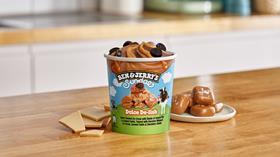
68. Ben & Jerry’s
2022’s rank: 62
Sales: £135.5m (–6.4%)
“Ice cream fans love to try new and interesting flavour combinations,” says B&J business lead Florence Howell. That explains the launch of Banoffee Pie as part of the new Sundae range, which made its debut in January 2022. The year also saw the relaunch of Moo-phoria as Lighten Up.
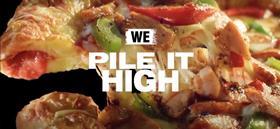
69. Chicago Town
2022’s rank: 65
Sales: £135.3m (–1.3%)
Chicago Town has slowed its value decline – but due only to a 15.1% rise in average price. Units are down 14.3%.
Trendy NPD such as Salt & Pepper Chicken and Picante Nduja – unveiled in September – aims to slow those losses by keeping the pizza brand “front of mind for consumers”.
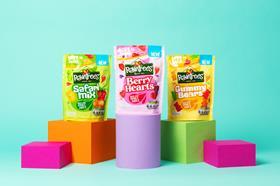
70. Rowntree’s
2022’s rank: 76
Sales: £134.9m (+8.7%)
Rowntree’s has banked an extra £10.8m on volumes up 5.5%. That’s 6.1 million more packs of sweets. The brand credits the “extremely successful” launch of Tropical Tots in early 2022. Plus, the cost of living crisis is driving sales of sugar confectionery “as an affordable treat”, it says.

71. Irn-Bru
2022’s rank: 69
Sales: £134.9m (+4.1%)
In January 2022, the posh Irn-Bru 1901 variant – previously only available in a large format – was poured into a 330ml can. It kicked off a positive year for Irn-Bru, which is up £5.3m. The priority in 2023 will be “building brand equity and increasing presence”, says owner AG Barr.

72. Kleenex
2022’s rank: 91
Sales: £134.4m (+19.8%)
Kleenex’s soaring value follows £3m of marketing spend in 2022. Next up will be a pack rebrand that “better clarifies our product benefits”, says owner Kimberly-Clark. This year will also see the launch of Kleenex Mega – a bigger format that “allows for a competitive price point”.
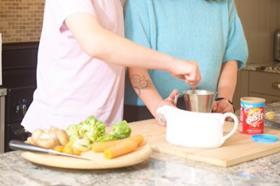
73. Bisto
2022’s rank: 64
Sales: £133.7m (–3.4%)
Like roast dinner stablemate Aunt Bessie’s (86), Bisto is having a rough ride. The brand’s volumes are down 17.9%. But Bisto is positive it can bounce back with marketing investment and “insight-driven NPD” such as pigs in blankets gravy granules, launched in time for Christmas 2022.
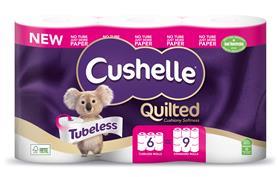
74. Cushelle
2022’s rank: 71
Sales: £132.3m (+3.0%)
Like Essity stablemate Plenty (87), Cushelle’s seen a dramatic rise in average price per pack. It’s up 21.7%, while units are down 15.4%. In a bid to stymie losses, Cushelle added oversized Tubeless rolls in August – “the most significant innovation in the toilet tissue category for years”.
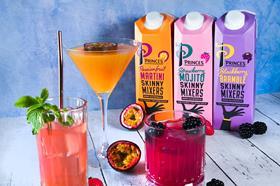
75. Princes Foods
2022’s rank: 82
Sales: £132.1m (+8.4%)
Princes’ volumes fell 10.9% – in part due to “retailers’ moves to reduce overall category space and simplify ranges”, it says. However, it’s “now seeing such decisions reversed”. And it’s trying to improve perceptions of ambient food through marketing and new lines like Skinny Mixers.
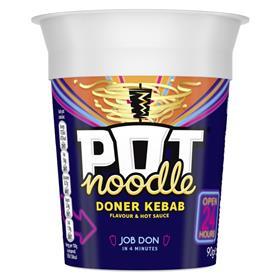
76. Pot Noodle
2022’s rank: 84
Sales: £131.9m (+10.1%)
Doner kebab and gravy & stuffing variants, plus a reformulation and expansion for Lost the Pot block noodles, featured in a busy year for Pot Noodle. It also debuted in festive gifting to tap “demand for affordable, Christmas-themed novelty gifts”. The Unilever brand is now £12.1m better off.
77. Kenco
2022’s rank: 63
Sales: £129.0m (–8.8%)
Facing a £12.5m slump in value and 23% volume decline, Kenco is hoping to create “even more consumption occasions” with its Iced/Hot Latte – added with some ceremony last year. Its posh Millicano range also has a fresh new look to jazz up those at-home flat whites.
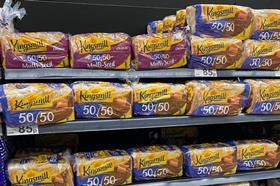
78. Kingsmill
2022’s rank: 66
Sales: £128.5m (–4.3%)
While distribution and volumes fell amid a “turbulent trading environment”, Kingsmill continued to perform well in convenience and wholesale, says Allied Bakeries MD Chris Craig. Its flagship 50/50 loaf remained the standout performer in the “healthier white” sector.
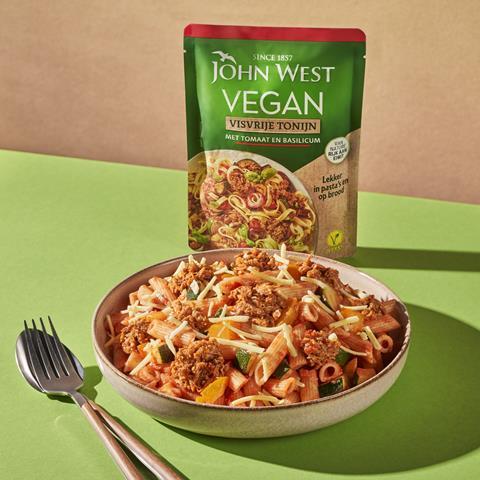
79. John West
2022’s rank: 61
Sales: £127.4m (–13.9%)
John West faced “an increasingly competitive retailer environment” in 2022, admits recently appointed international marketing director Vikki Babb.
However, the brand is confident its 24% slump in volume sales can be reversed in 2023.
Lines aimed at lunchboxes and convenient meals are at the heart of this recovery plan, with a focus on “added value no drain products in a can, and in our convenient fridge pot and our on-the-go salads and tuna pots”, Babb adds.
As the cost of living crisis rages, emphasising value will also be key to the brand’s ambition. Not only is ambient fish an affordable protein source, says Babb, it also provides the “added benefits of no need to heat, no need to use electricity for storage, long shelf life, and versatility for numerous dishes”.
Which means John West is able to “provide shoppers with healthy and nutritious meals even during times of hardship”, she adds.
Health benefits, too, will loom large in John West’s messaging, following last year’s £2m push for its Enriched range and announcement of a four-year deal with ParalympicsGB to be the team’s official protein partner.
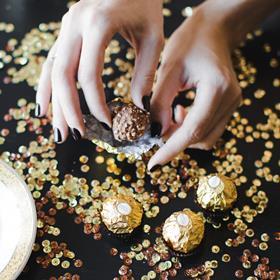
80. Ferrero
2022’s rank: 86
Sales: £125.6m (+7.5%)
Festive periods “provide significant opportunities” for Ferrero, says UK&I sales director Jason Sutherland. For instance, “our Ferrero Rocher Easter collection grew 10.8% year on year”. That and the addition of a 90g tablet range were among drivers of the brand’s £8.8m gain.
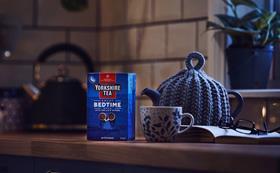
81. Yorkshire Tea
2022’s rank: 83
Sales: £125.1m (+3.8%)
Yorkshire Tea managed to add £4.6m despite a lack of innovation and a 2% dip in units. A 5.9% rise in average pack price was the main driver of value gains, but the brand also credits TV and in-store marketing – including the return of its ‘Where Everything’s Done Proper’ campaign.
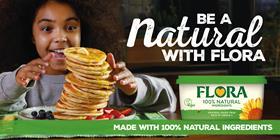
82. Flora
2022’s rank: 87
Sales: £121.8m (+4.3%)
Amid surging input costs in 2022, Flora shrank its 500g tub to 450g without a cut in price. The brand also returned to TV in April for the first time in three years. The ‘Be a Natural’ campaign celebrated Flora’s 100% natural ingredients – as it worked to recoup a units decline of 14.9%.
83. Ben’s Original
2022’s rank: 77
Sales: £119.9m (–2.4%)
After a tumultuous 2021, last year was relatively quiet for Ben’s. The main news was its new microwaveable meals range, Ben’s Plant-Powered. There was controversy on pricing, though: average packs got 9.1% costlier, while pouches shrunk 12% in early 2023 to mitigate soaring costs.
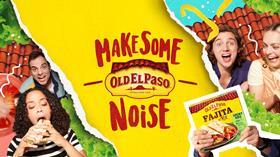
84. Old El Paso
2022’s rank: 75
Sales: £119.5m (–5.0%)
Decline in demand for cooking sauces and meal kits saw category leader Old El Paso shed £6.2m, with volumes falling 6.4%. With at-home eating on the rise again, the brand has launched meal bundles featuring Coca-Cola and El Jimador tequila, reporting a sales uptick since the start of 2023.

85. Duracell
2022’s rank: 74
Sales: £119.3m (–5.8%)
An 11.8% drop in units signals Duracell’s pandemic-powered boom is over. That’s not surprising: Brits have been working their way through batteries stockpiled during lockdowns. But it didn’t slow the brand’s bunny mascot, who was seen in a TV ad helping a couple with a flat power tool.
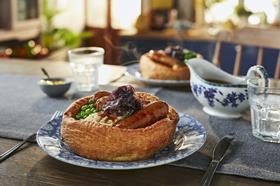
86. Aunt Bessie’s
2022’s rank: 78
Sales: £117.8m (–4.1%)
Poor Aunt Bessie is looking a little unloved. The brand has lost £5m, while volumes have slumped 17.3%. However, this is against pandemic-driven highs. Aunt Bessie’s is now focusing on NPD – such as its latest five-strong range of meat joints – in anticipation of another frozen boom.
87. Plenty
2022’s rank: 88
Sales: £117.2m (+1.7%)
Plenty’s 26% rise in average pack price is the sharpest in the top 100, masking a 19.3% volume decline. With production “significantly more expensive” due to rising energy, pulp and transport costs, owner Essity “had no option but to increase prices”, the supplier insists.

88. Ribena
2022’s rank: 83
Sales: £117.1m (–0.7%)
As part of a makeover last summer, Ribena added Sparkling Zero Sugar to sidestep the HFSS clampdown. It comes in 500ml and two-litre bottles – the latter aimed at money-saving big nights in. The brand also launched Sparkling PMPs to offer value in convenience.

89. Ginsters
2022’s rank: 89
Sales: £116.2m (+1.4%)
Ginsters has solidified its position as grocery’s number one savoury pastry brand. Value has edged up £1.6m on the back of a 9.5% rise in average price per pack.
Performance was driven by its core range of pasties – up 13.1% in value. And its Bakes lineup continued to grow following its launch in October 2021, adding 221,000 shoppers and an extra £0.6m.
Ginsters is now continuing to expand its portfolio. Its Meatball Marinara slice has become “a firm favourite” with Brits, delivering £0.6m in the nine months since its launch last May, the brand says.
It also brought back its limited-edition Festive Chicken & Stuffing Slice, which added £0.5m during the Christmas period and contributed to Ginsters’ highest-ever December market share, with 52% of incremental sales.
In spite of rising financial pressures, Ginsters has backed this NPD with advertising. It was back on TV in the first half of 2022 with a £1.2m push focusing on taste and comfort.
“Despite the present challenges, we believe it is an exciting time for the savoury pastry category and, in challenging economic times, we continue to offer an affordable meal,” says MD Sam Mitchell.
90. Finish
2022’s rank: 81
Sales: £116.0m (–4.9%)
“Post-pandemic norms continue to shape Finish’s place in people’s daily lives,” says brand experience lead Owen Renault. Fewer meals at home means less washing-up; unit sales have fallen 9.9%. But he points to more dishwasher loads per week than pre-Covid due to hybrid working.
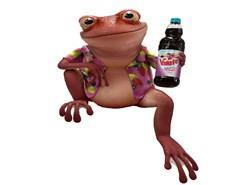
91. Vimto
2022’s rank: 93
Sales: £113.8m (+3.5%)
Vimto’s £3.8m gain is entirely due to a 7.1% rise in average pack price. Volumes declined 3.4% as the overall squash category slumped post-lockdown. A move into energy drinks could be on the cards: owner Nichols last year applied to register the name Vimto Energy with the IPO.
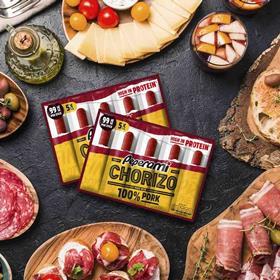
92. Peperami
2022’s rank: 99
Sales: £113.1m (+11.1%)
Peperami’s £11.3m gain follows NPD aimed at families and young adults looking for healthier snacks. Roasted Chicken Bites and Chorizo and Vegerami sticks broadened the brand’s repertoire, which it hammered home with a “six-figure” push centred on “funny snacking occasions”.
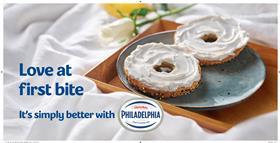
93. Philadelphia
2022’s rank: 92
Sales: £112.4m (+0.7%)
After adding its first plant-based variant in January 2022, Philadelphia expanded again in September with Intense – which offers an “extra creamy, aerated texture”. It couldn’t stop overall volumes falling 5.8%, hence new marketing last month to highlight the cheese brand’s versatility.
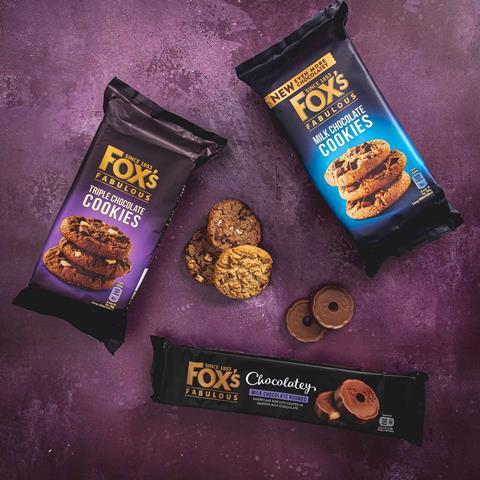
94. Fox’s
2022’s rank: 116
Sales: £112.3m (+25.2%)
Bursting into the top 100 with a £22.6m gain, Fox’s benefited from shoppers turning to sweet biscuits as an affordable indulgence. A portion of that value growth, inevitably, came from higher prices –but volumes also jumped 15.1%.
Fox’s biscuits were bought by 56% of households in Britain over the past year, according to trade marketing director Colin Taylor – a 4.7% increase. Shoppers also bought the brand more frequently year on year, he adds.
“Within biscuits and cakes, like many other categories, consumers are consistently drawn to brands they trust, which presents an opportunity for retailers to stock popular favourites, with the likelihood they’ll be purchased.”
Fox’s Rocky, Fabulous Cookies and Fabulous Chocolatey Rounds ranges drove performance. Fabulous lineups were supported by above-the-line activity, while Chocolatey Rounds added a salted caramel variant that made almost £2m.
Fox’s sales were further boosted by the return of on-the-go sales, says Taylor. “Our much-loved Rocky and Party Ring Minis products have shown strong growth, driven by the portability and portion control they offer.”
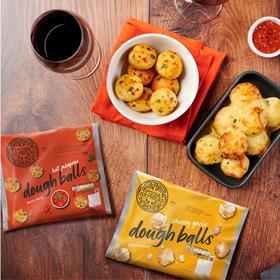
95. Pizza Express
2022’s rank: 95
Sales: £110.9m (+3.5%)
NPD has helped Pizza Express grow value. Cheesy Dough Balls, Hawaiian pizza and the premium, herb-infused Siciliana range are aimed at Brits “increasingly favouring restaurant experiences at home”, says retail director Richard Mills. “We remain at the forefront of this trend.”

96. Rustlers
2022’s rank: 95
Sales: £110.8m (+4.9%)
With more cheaper packs through tills, Rustlers’ average price fell 8.6%, but volumes rocketed 14.7% to increase sales by £5.2m. The highly innovative Pancake Stack bagged the Champion of Champions accolade at The Grocer New Product Awards 2022.

97. Fever-Tree
2022’s rank: 67
Sales: £107.5m (–18.9%)
A post-Covid loss of £25m – driven by a 23.3% dive in volumes – means Fever-Tree is close to dropping out of the top 100. But the posh mixers maker insists it’s “well-positioned to capture” the continuing growth of premium spirits. As such, it’s preparing to innovate in coming months.

98. Maynards Bassetts
2022’s rank: 97
Sales: £106.9m (+5.3%)
With units up 2.1%, the thriving brand’s key launch has been the non-HFSS Juicies range with 30% less sugar. Added in July, it “provides shoppers with that great-tasting, lower sugar confectionery option”, says Susan Nash, trade communications manager at owner Mondelez.
99. Dettol
2022’s rank: 93
Sales: £103.9m (–6.0%)
In 2021’s report, Dettol rocketed into the top 100 with a value gain of over 60%. Two years later, it’s almost back where it started. The brand shifted 3.3 million fewer packs last year, losing £6.6m. That’s not surprising given Covid’s household hygiene craze is becoming a distant memory.
100. Napolina
2022’s rank: 90
Sales: £103.1m (–8.6%)
With the Italian food category continuing to grow, Napolina last year invested £2m in “a major marketing overhaul”, says brand marketing director Jeremy Gibson. Despite having suffered a number of delistings, “we are positive about a recovery on distribution points in the near future”.
Notes
Brand values in this report are the sum of value sales of all products across multiple categories trading under one name, specified on the front of pack. For example, Coca-Cola is the sum of Classic Coke, Diet Coke, Coke Zero Sugar and all flavour variants. In instances where there is a masterbrand on the front of pack alongside a sub-brand – such as Nestlé Kit Kat – the masterbrand will be taken as the primary brand. But in instances where the masterbrand is not visible on pack – for example, Mars’ Galaxy – the sub-brand will be counted as a brand in its own right.
Arla: Products from sub-brands with the Arla name on, including Lactofree and Cravendale. Excludes Anchor and Lurpak.
Cadbury: Products sold under the Cadbury brand including sub-brands such as Dairy Milk. Includes cakes, biscuits, potted desserts, drinking chocolate and ice cream.
Danone: All yoghurt products across the Activia, Actimel, Danio, Oykos and Light & Free sub-brands.
Fairy: Products from all sub-brands across the detergents, dishwash and fabric conditioners categories.
Heinz: All products sold under the Heinz name spanning soup, ketchup, beans and frozen categories.
Kellogg’s: Products across all sub-brands in the cereals, cereal bars and snacking categories
Müller: Products sold under the Müller milk and yoghurt brands including Black & White, The One, Dairy Crest Milk, Frijj, Müller Corner and Müllerlight. Excludes Dairy Crest cheese.
Nestlé: Products that bear the Nestlé brand on the front of pack including cereals, Kit Kat and other confectionery, such as Quality Street and Smarties. Excludes Nescafé.
Purina: Products sold under Purina sub-brands including Felix, Gourmet, Bakers, Go Cat, Winalot, One and Bonio.
Walkers: Products from all snack brands including Sensations, Quavers and Wotsits.
Wrigley’s: Products from all Wrigley’s sub-brands including Extra, Airwaves, Doublemint and Spearmint.
Young’s: Includes fresh and frozen branded Young’s fish products.
Methodology
The data in Britain’s Biggest Brands 2023 is for the period 52 w/e 31 December 2022. Data is taken from NIQ’s retail measurement service, which monitors weekly sales from a nationwide network of EPoS checkout scanners covering the grocery and convenience markets.
NIQ’s retail measurement service provides comprehensive information on actual purchases, market shares, distribution, pricing and promotional activities, which it says is the fastest and most accurate measure of consumer sales. Its services are constantly being improved to reflect the grocery marketplace.
NIQ Total Coverage now includes EPoS data from Wilko, Superdrug and Boots, and excludes any estimation for Aldi and Lidl.
NIQ offers consulting services on product innovation, retail and shopper strategies, market structure and segmentation, brand and portfolio management, marketing performance, pricing and promotional strategies, advertising effectiveness and social media intelligence, based upon expertise and data assets.
NIQ’s retail measurement services provide the fmcg industry with expert information and analysis of consumers, categories and the retail marketplace.
For the purposes of this report, a brand is defined as all products within categories that are sold and marketing under a given brand name specified on front of pack.
The report includes grocery and household categories and does not include baby, tobacco, alcohol, personal care or OTC.
How Britain’s 100 biggest brands are innovating through a cost of living crisis
- 1
- 2
- 3
- 4
- 5
 Currently reading
Currently readingBritain’s Biggest Brands 2023: The top 100
- 6
- 7



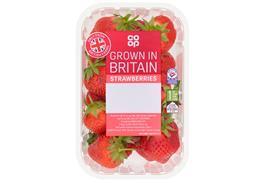









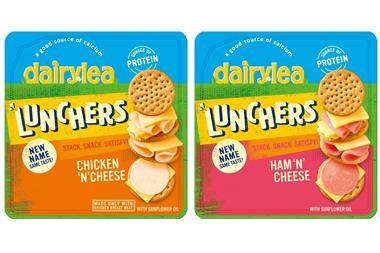
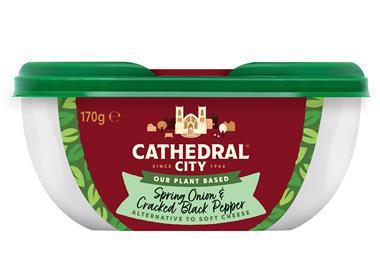
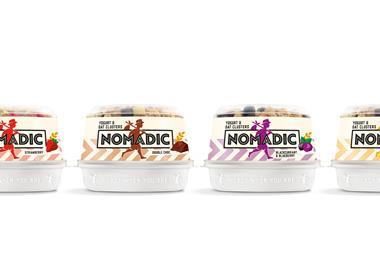
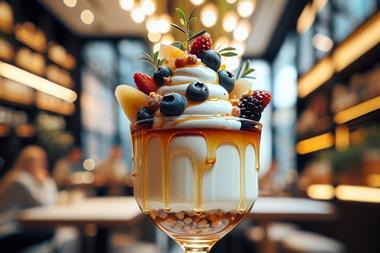
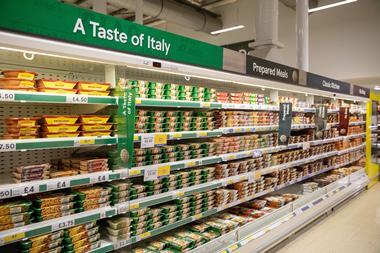
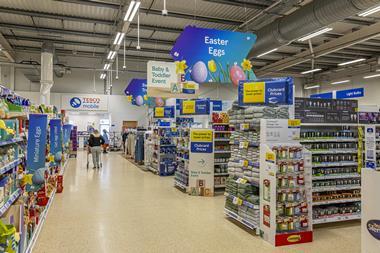

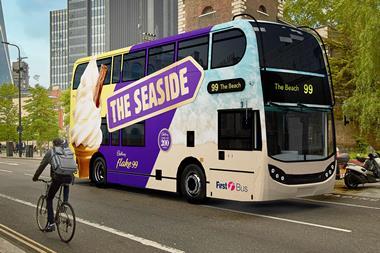

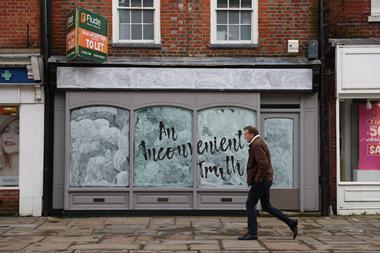
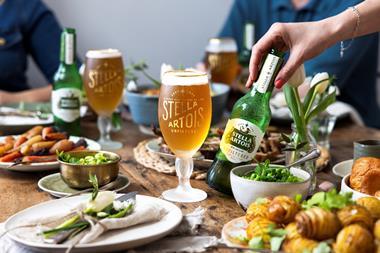

No comments yet